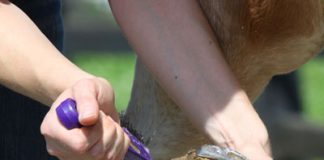A horse that over-reaches grabs the heels of his front feet with the toes of his hind feet. Often, a horse is predisposed to over-reaching due to a compact build and disproportionately long legs. Performance horses are also in danger of over-reaching because they fully engage their hindquarters to propel themselves forward. Another cause of over-reaching is deep or muddy footing. When ridden on soft ground, a horse’s feet sink into the soil. As the hind feet reach forward, they strike the partially submerged front heels. All of these issues can lead to a lost front shoe. In the worst case scenario a horse can suffer a bruised or cut heel, both of which can lead to acute lameness.
Bell boots help to safeguard against over-reaching. They encircle the horse’s leg at the pastern and drape over the sensitive heel. Bell boots come in several different styles. Because of their easy application, those that fasten with Velcro straps are the most popular. The main drawback, however, is that Velcro tends to collect dirt and grit and loses its adhesive properties when wet. A better choice for wet footing or winter weather is the pull-on style. Constructed of one solid piece, they stay on regardless of the environment. Getting them on your horse, however, can be tricky until you get the hang of it.
Before you start, make sure you select pull-on bell boots made of pliable rubber, sometimes referred to as “gummy rubber.” Next, make sure they are the proper size. If you can fit a finger’s width between the rim of the bell boot and your horse’s pastern, they won’t chafe. But too large and they’ll be ripped off when your horse over-reaches. In general, ponies wear size small. Refined breeds like Arabians and smaller
Quarter Horses wear mediums. The typical Thoroughbred, larger stock-horse breeds and warmblood crosses use a size large. The extra large pull-on bell boots are reserved for sport horses. Finally, give yourself some time to practice pulling the bell boots on over your horse’s feet. Once you get the knack, it’s easy.
|
Turn the bell boot inside out. Lift up your horse’s front foot as if you’re going to clean it with a hoof pick. Now pull the bell boot on, beginning with the actual bottom first. As you get to the top of the bell boot, the opening will be smaller. Go ahead and tug on the sides of the bell boot and stretch the rubber until the hoof pops through.
|
Step Two:
Let your horse put his foot down. The bell boot will be inverted (inside out). Simply flip it into place.
 Step Three |
Step Three:
Also, if you leave the boots on for several days at a time, frequently check them to make sure mud, sand or pebbles haven’t accumulated between the boot and your horse’s heel. Such a build-up can abrade your horse’s heels, a situation you’re trying to avoid.








Thank you for the info. I have never heard of leaving boots on for days on end. I have never had to use bell boots, but I’m sure this information will come in handy some day.
neat product!
My horse needs those.
Thank you for this article….my horse has over reached so just recently we bought a pair of bell boots for her, it was tricky getting them on! If I would have seen this article first however, it would have been lots easier! It will come in handy!
neat!
I need to buy a pair, and this helped before I buy!
Thanks for the great tips!
“the
‘sectret
‘ is water; wet the head/ neck of the bell boot in water before pulling it on; When removing just squeeze water on the lower leg, pastern, head/ neck of bell boot; it will slide right off; I remember well all the struggling I went through before I learned that